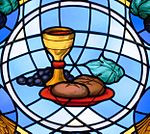
Back Adoració eucarística Catalan Eucharistická adorace Czech Eucharistische Anbetung German Adoración eucarística Spanish Gurtza eukaristiko Basque Adoration eucharistique French Euharistijsko klanjanje Croatian Adorasi Ekaristi ID Adorazione eucaristica Italian 성체 조배 Korean

| Part of a series on the |
| Eucharist |
|---|
 |
Eucharistic adoration is a Eucharistic devotional practice primarily in Western Catholicism, but also to a lesser extent in certain Lutheran and Anglican traditions, in which the Blessed Sacrament is adored by the faithful. This practice may occur either when the Eucharist is exposed, or when it is not publicly viewable because it is reserved in a place such as a church tabernacle.
Adoration is a sign of devotion to and worship of Jesus Christ, who is, according to Christian tradition, present in body, blood, soul, and divinity, under the appearance of the consecrated host, that is, sacramental bread. From a theological perspective, the adoration is a form of latria, based on the tenet of the real presence of Christ in the Blessed Sacrament.[1]
Christian meditation performed in the presence of the Eucharist outside Mass is called Eucharistic meditation. It has been practiced by such as Peter Julian Eymard, Jean Vianney and Thérèse of Lisieux. Authors such as Concepción Cabrera de Armida and Maria Candida of the Eucharist have produced writings recording their Eucharistic meditations.
When the exposition and adoration of the Eucharist is constant (twenty-four hours a day), it is called perpetual adoration. In a monastery or convent, it is done by the resident monks or nuns and, in a parish, by volunteer parishioners since the 20th century. In a prayer opening the Perpetual chapel in St. Peter's Basilica, Pope John Paul II prayed for a perpetual adoration chapel in every parish in the world.[2] Pope Benedict XVI instituted perpetual adoration for the laity in each of the five sectors of the diocese of Rome.[3]
- ^ Schadé, Johannes P., "Eucharistic adoration", Encyclopedia of World Religions, 2006, ISBN 978-1-60136-000-7
- ^ "Eucharisticum Mysterium - Instruction on Eucharistic Worship, 53". Adoremus Bulletin. 25 May 1967. Archived from the original on 22 June 2019. Retrieved 26 April 2017.
- ^ "Meeting with the Clergy of the Rome Diocese (March 2, 2006) | Benedict XVI". w2.vatican.va. Retrieved 24 December 2018.
© MMXXIII Rich X Search. We shall prevail. All rights reserved. Rich X Search